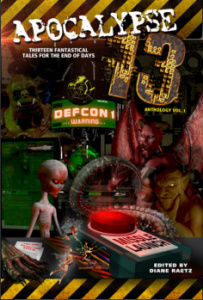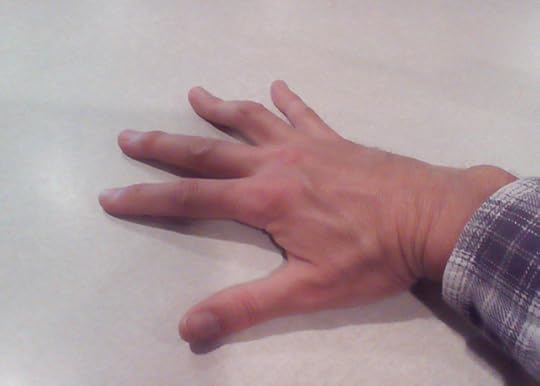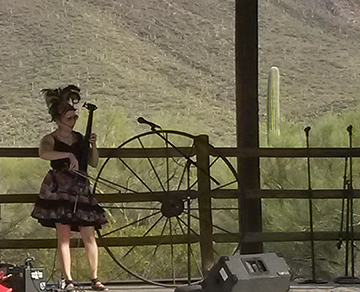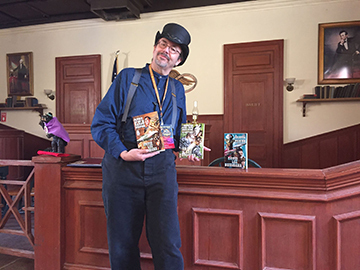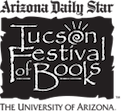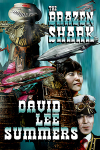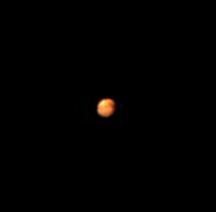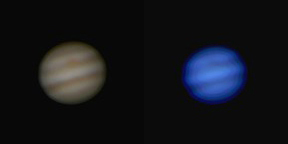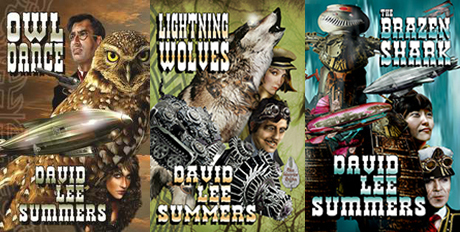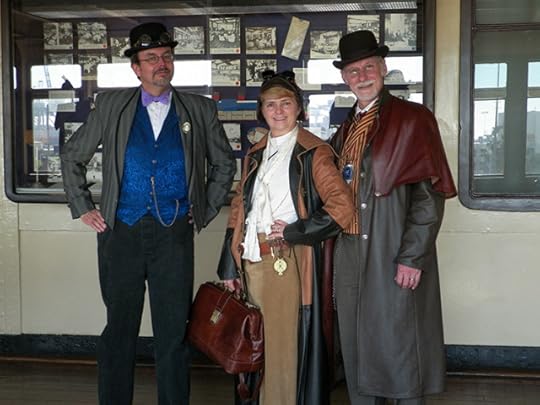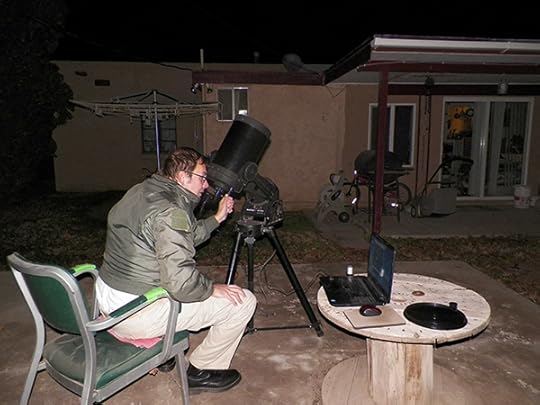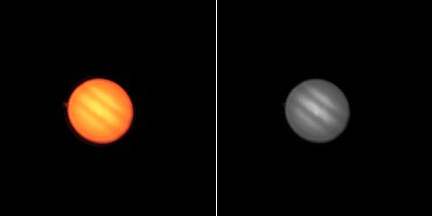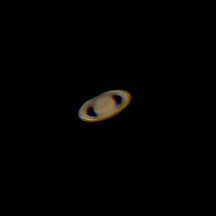David Lee Summers's Blog, page 99
March 26, 2016
Join the Clockwork Legion!
I need your help. I’ve written nine novels and I have a tenth on the way later this year. 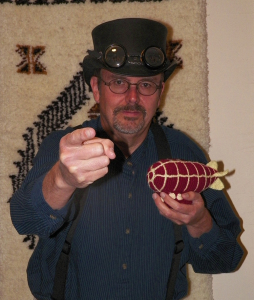 The objective is to get those novels into the hands of the people who will enjoy them. There are lots of ways to help. People on Twitter can tweet and retweet about books. People on Facebook can share my posts. Readers can share their reviews on Amazon and Goodreads. Several of you reading this post have done so already and for that I am extremely grateful. As long as I’m writing books you like, please continue.
The objective is to get those novels into the hands of the people who will enjoy them. There are lots of ways to help. People on Twitter can tweet and retweet about books. People on Facebook can share my posts. Readers can share their reviews on Amazon and Goodreads. Several of you reading this post have done so already and for that I am extremely grateful. As long as I’m writing books you like, please continue.
That said, I’m hoping I can encourage a few of you to step up for an additional challenge and commit to helping me spread the word about releases and events as they happen. Perhaps you could help recruit people to sign up for my newsletter. Maybe we could create a group on Facebook where I can share news and ask for you to share it among your friends. If you attend conventions, perhaps I could send bookmarks or postcards to you. Perhaps you have an idea you’d be willing to share in the comments. There would be rewards for those committing to the promotional effort, such as the hand-crocheted airship I’m holding, courtesy of my wife. If you think joining the Clockwork Legion and helping me get the word out would be fun, send me a message or leave me a comment and we’ll discuss it further.
For those who might have missed it, I was featured this week in Padwolf Publishing’s March of Authors event on Facebook. My story “A Garden Resurrected” appears in the anthology Apocalypse 13, which is available at Amazon. During the event, they asked me if my story were to be made into a movie, who would direct it and who would star in it. Here’s what I answered: “My Padwolf story ‘A Garden Resurrected’ is being made into a movie with Joss Whedon directing. It stars Bill Murray as the vampire Graf Schaefer with Karl Urban as the Burgermeister and Emma Watson as his daughter Heidi. By turns, funny, thoughtful, and frightening, ‘A Garden Resurrected’ tells the story of a Burgermeister who fights to save his idyllic mountain village as an asteroid plummets toward the Earth. He dares to wake an ancient vampire who once saved the town from plagues and invasion, but what is the cost of such a savior?” Hope you’ll take some time and check out this great little anthology.


March 19, 2016
Beating Arthritis
In the early 1990s, I started noticing sharp pains in my left foot. When I started work for Kitt Peak National Observatory in 1992 and had good insurance, I went to my doctor to have it checked out. After the podiatrist took a look at the X-ray, he looked up up at me and said, “You walked in here?” It turned out nearly a third of the ball joint on my left foot had eroded away due to arthritic inflammation.
I was sent to a rheumatologist who diagnosed me as having psoriatic arthritis, a somewhat rare form of arthritis that has the same root cause as the skin disease, psoriasis. Given that it was a chronic disease I came to accept there would never be a cure. 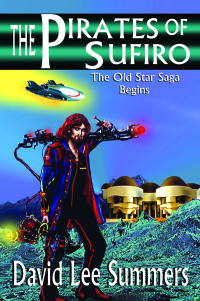 My doctor did a good job of slowing it down with methotrexate—a chemotherapy drug used to keep my own immune system from attacking my body. Over the years, I lost some hair and the arthritis continued to get worse. When I wrote my novel, The Pirates of Sufiro, I gave First Mate Roberts the same disease I had. Although the novel was set in the distant future, he was marooned on a distant world and had no more hope for a cure than I did. The exercise was therapeutic. It allowed me to imagine a character living a long a productive life despite a debilitating disease.
My doctor did a good job of slowing it down with methotrexate—a chemotherapy drug used to keep my own immune system from attacking my body. Over the years, I lost some hair and the arthritis continued to get worse. When I wrote my novel, The Pirates of Sufiro, I gave First Mate Roberts the same disease I had. Although the novel was set in the distant future, he was marooned on a distant world and had no more hope for a cure than I did. The exercise was therapeutic. It allowed me to imagine a character living a long a productive life despite a debilitating disease.
The disease went into remission soon after I moved to New Mexico in 1995. I stopped the methotrexate therapy with the blessing of a new doctor. There were still painful twinges, that reminded me it lingered in the background, but those were generally treatable with over-the-counter pain medication. However, the chronic nature of the disease reasserted itself big time in 2003. This time, I not only had pain in my feet but in my hands. I sought out a rheumatologist and he restarted the methotrexate therapy. He also helped me get shoe inserts that took the pressure off my toes, which helped tremendously. During this period of arthritic inflammation, the fourth finger of my right hand became swollen and suffered joint damage. That damage can be seen here.
Unfortunately, walking with a cane helped little. I was never in quite enough pain to require a wheelchair, though I admit I came awfully close. Because the arthritis wasn’t very visible, I never sought out a placard to park in any of the spots designated for disabled drivers. I never wanted to have an ignorant person shake their head disparagingly because they thought I was shamming my pain and taking a spot that someone else deserved—and frankly, bad as the arthritis pain was, I knew others who needed those spots more than I did. At this point in my life, I became even more convinced the arthritis would really disable me. This feeling was not helped when my rheumatologist pointed out that psoriatic arthritis has been known to inflame heart valve cartilage, creating even more problems.
In 2008, a new drug came on the market—Enbrel. My rheumatologist decided to give it a try and sure enough it helped. He suggested an aggressive treatment plan, essentially giving me the maximum recommended dosage. Over time, the arthritic inflammation subsided. After two years, he began to back off the dosages. Even with that, the arthritis remained in good control. Finally in late 2012, he gave me the option of stopping the medication. I felt good enough I agreed. Since then I’ve been seeing my rheumatologist annually and there has been no sign of the arthritis returning. I started exercising more regularly and lost some weight, which also helped. A little over a week ago at my regular visit, my doctor said he saw no reason to keep seeing me. It appeared the arthritis was not coming back anytime soon. However, I am welcome to call him if it does reappear.
Is the arthritis gone for good? Well, it is a chronic disease, so it could always rear its ugly head again. After all, it quieted down considerably for an eight-year period at one point. However for the moment, I feel pretty good—better than I did in the late 1990s—and I hope the story gives some hope for those who are suffering arthritic inflammation and fear it will never end. Of course, I can’t say that what worked (so far) for me will work for you. That’s something you would have to talk to your doctor about.
If you get angry because you see someone who appears to have “faked” a disability and has a placard or license plate indicating a disability when you don’t think they deserve it, please take a moment to reconsider. Some disabilities are invisible and you don’t know the pain that person is suffering or how it manifests.
Sadly, First Mate Roberts is stuck on the pages of my book, in a hover chair, suffering from his arthritis but he still gives me hope and helps me remember that disabled people can be productive and achieve great things. If you’d like to read his story, you can get the book for free at the Lachesis Publishing website.


March 12, 2016
Wrangling Sharks in the Wild West
This weekend, I’m at the Tucson Festival of Books on the University of Arizona campus. I’ll be on the Scientists Writing Science Fiction panel at 10am on Sunday morning in the Integrated Learning Center, room 151. I’ll be signing books afterwards. Also, be sure to stop by the Massoglia Books booth, number 446 to find out when I’ll be signing there.
I spent last weekend at Wild Wild West Con at Old Tucson Studios, which is always a treat. Old Tucson Studios is where many classic Western films from 3:10 to Yuma and Rio Bravo to Tombstone and The Quick and the Dead were made. Walking through the studios is like walking back in history in more ways than one.
I had to work the Thursday night before the convention, so I got a short nap and then drove down. 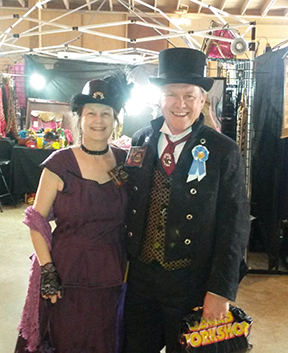 The only thing scheduled was a reading, which happened during the heat of the afternoon outside when there was little traffic. A few people dropped by and sat down in seats I set up in the shade and listened for a while, but I think if I propose a similar event for next year, I’ll suggest we do this as an indoor event. Meanwhile, my wife and daughter set up our artist table in the dealer’s room, which I shared with authors David Drake and Sparky McTrowell, who provided one of my cover quotes for The Brazen Shark. As it turns out, Bob Vardeman, the other author who provided a cover quote, was also there, though he didn’t participate in panels. He just decided to hang out and have fun. Another treat was that my co-worker from Kitt Peak, Bill Ball, was around on Friday along with his wife Deb. That’s them on the left.
The only thing scheduled was a reading, which happened during the heat of the afternoon outside when there was little traffic. A few people dropped by and sat down in seats I set up in the shade and listened for a while, but I think if I propose a similar event for next year, I’ll suggest we do this as an indoor event. Meanwhile, my wife and daughter set up our artist table in the dealer’s room, which I shared with authors David Drake and Sparky McTrowell, who provided one of my cover quotes for The Brazen Shark. As it turns out, Bob Vardeman, the other author who provided a cover quote, was also there, though he didn’t participate in panels. He just decided to hang out and have fun. Another treat was that my co-worker from Kitt Peak, Bill Ball, was around on Friday along with his wife Deb. That’s them on the left.
Friday night, my wife, daughter, and I went to a concert by the Dry River Yacht Club and Steam Powered Giraffe. 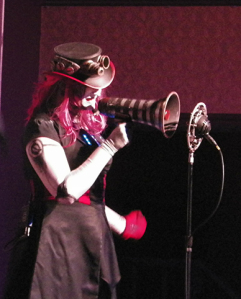 Both were excellent performances and really helped me get into the spirit of the event. Unfortunately, when we got back to the house where we were staying, I discovered my wife had left the garment bag at home with almost everything I planned to wear! Luckily, my wife did bring all my hats, I had an extra waistcoat, and our friend had a washer and dryer, so I was able to change out my look a bit for Saturday and still wear clean clothes!
Both were excellent performances and really helped me get into the spirit of the event. Unfortunately, when we got back to the house where we were staying, I discovered my wife had left the garment bag at home with almost everything I planned to wear! Luckily, my wife did bring all my hats, I had an extra waistcoat, and our friend had a washer and dryer, so I was able to change out my look a bit for Saturday and still wear clean clothes!
I was scheduled for two presentations on Saturday, but was drafted for a third. My first presentation was called “The Wild West: Real and Mythical,” but could have been renamed “How it Sucked to be Anything but Anglo in the Wild West.” We took a hard look at Native American, Latino, Irish, and the Chinese as they were treated. You may look at that list, and say “but the Irish are white,” but it was very eye-opening to see how they were denigrated and forced to conform to “society norms” much like the other groups. After that presentation, Diesel Jester invited me to be on a panel about researching steampunk, where we discussed various historical resources we’ve found useful. On the panel with me were Diesel, Justin Andrew Hoke, Cynthia Diamond, Rose Corcoran, and Sean Walter. For my last presentation of the day, I discussed astronomy around the world during the Victorian age. Part of the discussion actually involved what one would call “Victorian age” astronomy because different parts of the world developed different mathematical tools and concepts at different times. For example, the Arab world gave us many of the mathematical tools for astronomy back in the 11th and 12th centuries while some schools of thought in Asia viewed an infinite universe of free-floating objects long before the common era.
Not only did I go to presentations, but I did some shopping at the convention. Because, I suddenly found myself without much of my wardrobe, I bought a new shirt and a new hat. Also, going between presentations, I was lucky enough to catch several of the great presentations going on all around, including an outdoor concert by the extremely talented cellist and singer, Unwoman.
On the final day of the convention, I was scheduled for a panel on multicultural steampunk literature with the delightful Madame Askew. We had a great time recommending such books as The Peshawar Lancers by S.M. Stirling, Baba Ali and the Clockwork Djinn by Danielle Ackley-McPhail and Day Al-Mohammed, and Beyond the Rails by Jack Tyler. Again, Diesel Jester asked me to be on a steampunk writing panel I wasn’t scheduled for. I joined the same gang as the day before and we continued our discussion of the process of writing steampunk. I finished the day at El Charro, a wonderful Mexican Restaurant in downtown Tucson with many friends from the convention. In the photo below courtesy James Spring, I’m not only showing off my Clockwork Legion Books, but my new shirt and hat!
So, what does all this have to do with wrangling sharks? Well, this was the debut event for the third novel in my Clockwork Legion series, The Brazen Shark. I ended up selling out of all but two copies of the new novel. Fortunately, a fresh shipment was waiting for me when I returned to Las Cruces, so I have plenty of copies for the Tucson Festival of Books. If you missed both events, don’t despair, you can wrangle a shark of your own by visiting Amazon.com or BN.com.


March 5, 2016
2016 Tucson Festival of Books
This weekend, I’m at Wild Wild West Con, which is a steampunk convention being held at Old Tucson Studios just outside of Tucson, Arizona. If you’re in the area I hope you’ll drop by. The link above will take you to the convention’s home page where you can get more information. I hope to post some photos in the next couple of weeks.
Next weekend, I’ll be back in Tucson for the Tucson Festival of Books at the University of Arizona. Clicking the name or the logo to the left will take you to the festival’s home page for more information. I see lots of great authors scheduled including Greg Bear, Jeffery J. Mariotte, Marsheila Rockwell, Beth Cato, Diana Gabaldon, Jonathan Maberry, and many more. I’m scheduled for the following event:
Scientists Writing Science Fiction:
Two real life scientists discuss writing science fiction.
Location: Integrated Learning Center Room 151
Time: Sun, Mar 13, 10:00 am – 11:00 am
Signing area: Sales & Signing Area – Integrated Learning Center (following presentation)
I’ll be on this panel with Chris Impey.
I will also be signing books at the Massoglia Books Booth during the weekend. Be sure to stop by the book and check for times. They’re booth number 446 and in addition to my books, they have an outstanding selection of used and collectible books. I can easily spend hours just browsing their selection.
Hope to see you there!


February 27, 2016
Wild Wild West Con 5
Next weekend, I’m honored to be a guest at Wild Wild West Con 5 held at Old Tucson Studios just outside Tucson, Arizona from March 4-6, 2016. Click on the link above for more details. This year’s theme is Journey Around the World. Among the honored guests are Steam Powered Giraffe, Thomas Willeford, Unwoman, Kato, Aiden Sinclair and many more. Below is my schedule for the event.
Friday, March 4
2pm – Wagon Stage – History Meets Fiction. Join me for a special multi-cultural steampunk reading. I’ll present accounts of New Mexico witches and Japanese spirits, then share sections from my novels these stories inspired.
Saturday, March 5
2pm – Arizona Theater – The Wild West: Real and Mythical. A look at the real West vs the West that Hollywood has given us with an emphasis on Native American, Latin American, and Asian cultural contributions and influences. Joining me on the panel will be David Grasse, Julia Arriola, and Mark Cantwell.
5pm – Sheriff’s Office – Astronomy Around the World. People all around the world have looked up at the stars. I’ll you to such places as Ecuador, Korea, and the Middle East to see how astronomy changed the world and perhaps provide some inspiration for new types of steampunk stories and gadgets
Sunday, March 6
11am – Courtroom Central – Multicultural Steampunk Literature. The ever delightful Madame Askew and I will lead a discussion of steampunk books set in other cultures. Who does their homework and presents the most interesting insights into parts of the world that aren’t just Victorian England or the Wild West?
When I’m not on panels, you’ll be able to find me over at the Stage 2 Vendor Area at one of the artist tables. This event is particularly special because it also is my debut signing for The Brazen Shark. If you already have a copy, be sure to bring it by for me to sign it. If you don’t have a copy yet, never fear, I’ll have plenty of copies available for sale.


February 20, 2016
Cowboy Bebop
A couple of weeks ago, I was browsing through the video section of a local store when I came across a recent release of the TV series Cowboy Bebop. Although I’ve been an anime fan since I first saw Gigantor in the early 1970s, I managed to miss Cowboy Bebop’s debut on the Cartoon Network circa 2001. 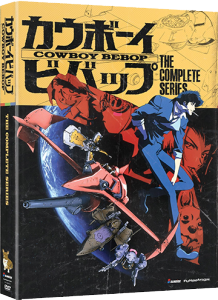 That was right after my wife and I decided that we weren’t getting enough out of cable to keep paying an exorbitant bill every month. I’d seen two or three episodes over the years at science fiction conventions and knew that I wanted to actually watch the series, so I picked it up.
That was right after my wife and I decided that we weren’t getting enough out of cable to keep paying an exorbitant bill every month. I’d seen two or three episodes over the years at science fiction conventions and knew that I wanted to actually watch the series, so I picked it up.
If you’re like me and late to discovering Cowboy Bebop, it’s the story of two bounty hunters: a former cop named Jet Black and a former mob enforcer named Spike Spiegel, who travel through the solar system in a space ship called the Bebop looking for criminals to nab. As the series progresses, they’re joined by Faye Valentine, a bounty hunter with a mysterious past; Ein, a Welsh Corgi with a brain implant; and Radical Edward, a teenage girl who has mad computer skills. Unlike a lot of current anime, Cowboy Bebop has less of an overarching story and is more a series of self-contained episodes.
In this world Cowboys are Bounty Hunters, but space cowboy imagery runs through the series. Spike, Faye, and Jet all have their personal fighters, which are a little like their mechanical horses. There’s a sense of the solar system colonies on Mars and Jupiter’s moons requiring a kind of wild west frontier spirit to tame. Much of the look and feel of the show is reminiscent of Joss Whedon’s Firefly and if Whedon didn’t take some inspiration from Cowboy Bebop, then the similarities are a pretty big coincidence.
One of the great elements of Cowboy Bebop is a truly remarkable jazz soundtrack by Yoko Kanno and the Seatbelts. At points, the music slips away from the jazz and adopts a little lonely guitar to enhance the wild west feel.
Another thing that strikes me as especially well done is the characterization of Radical Edward. As the father of a bright teenage girl, she hits many of the right notes. Edward can be persuaded to be useful, but most of the time is more interested in sleeping, eating, or doing her own thing, which sometimes horrifies or confuses the adults around her.
My only real issue with the series is that it’s set in 2071, and though I would love to have many well populated colonies out in the solar system by then, I’m hard pressed to believe it will happen. Despite that, I love the look of the series and have long been attracted to the idea of stories about the rugged individuals who will go out and forge new lives among the stars, such as my novel The Pirates of Sufiro. In my story, space pirates are stranded on a distant world and must make a life there in a story that took some inspiration from my great grandparents who homesteaded in New Mexico and Texas. The link in the title will take you to the free PDF edition distributed by my publisher, which is my preferred edition.
Finally, I’ll wrap up today’s post with a brief update. At this point, we’ve decided that Tales of the Talisman will remain closed through 2016. However, Hadrosaur Productions will be reading for an anthology this year tentatively on the theme of Space Cowboys. Like the space cowboys of Cowboy Bebop and The Pirates of Sufiro, these are not necessarily literal cowboys, but people who embody the frontier spirit. Some may be quick with their blaster. Some may have to use their wits to survive in a harsh environment. Some may just be the people who are happy to be alone riding the range of space when no one else wants to. I hope to have guidelines posted at the Tales of the Talisman website by April, with the reading period this summer. Till next week…see you space cowboy.


February 13, 2016
Elusive Mars and Majestic Jupiter
The weather in the Southwest has dried out and warmed up, which inspired another session in the back yard with my Celestron 8-inch telescope and Orion StarShoot USB Camera. My primary hope was to capture Mars. Now Mars is a notoriously difficult target for a small telescope. It’s an orb in slightly varying shades of red. To see any detail at all is a challenge. In the book Cosmos, Carl Sagan described Percival Lowell’s challenges observing Mars:
Observations of this sort are not easy. You put in long hours at the telescope in the chill of the early morning. Often the seeing is poor and the image of Mars blurs and distorts. Then you must ignore what you have seen. Occasionally the image steadies and the features of the planet flash out momentarily, marvelously.
I couldn’t say it better myself. I watched the planet for several minutes. Every now and then I’d see the polar cap appear and occasionally a dark feature would join it. I put in my video camera and most frames came out as red blurs, though a few showed a hint of structure. I used the RegiStax 6 package to combine the images and work to bring out the structures and was able to get this image.
When I first saw the images, I thought the telescope was slightly out of focus because Mars was slightly oblong. However, checking Sky and Telescope magazine, it turns out that the relative positions the planets mean Mars is in a slightly gibbous phase right now. We actually can see the terminator from Martian day to night. Perhaps it’s because this little desert world is at once similar to ours but challenging to really resolve well that we find it so fascinating.
Looking at it through the telescope and even on the video screen, I thought I could convince myself that I saw linear structures like canals. Even without canals, a visit would be fascinating and I’ve imagined going there in my fiction. In my story “Arachne’s Stepchildren” which appears in The Martian Anthology, I imagine miners on Mars actually finding life deep underground. In my novel The Solar Sea, the solar sail Aristarchus stops by the planet and a landing party visits the summit of Olympus Mons, the tallest mountain in the solar system. In the novel, the astronauts continue on to Jupiter and so did I. Here are images of Jupiter without a filter and through a blue filter.
The exciting part of this image is that you can see the Great Red Spot, the solar system’s longest lasting storm, in the upper brown belt near the planet’s center. It’s a bit faint, elusive like Mars, but it’s a little more apparent in the blue filter.
Even without a telescope, it’s worth stepping out the door if you happen to be up a little before sunrise. Mercury, Venus, Mars, Jupiter, and Saturn are all visible without a telescope. In fact, with a sufficiently large telescope, you would find Pluto not far from Mercury and Venus right now. I enjoy going out and looking even though my “day” job involves long hours with the telescope. It helps to make a personal connection to those objects in the sky which inspire us and it gives me the opportunity to share those wonders with my family.


February 6, 2016
On Writing Alternate History
There is a maxim that if you write a story set in history, you better be sure your research is meticulous because if you make a mistake, someone is going to let you know about it. However, it doesn’t take much research to realize the truth of another old saw, “history is written by the victors.” To complicate matters further, a lot of people know their history from popular culture such as other fiction books or movies, so sometimes our hypothetical “someone” mentioned at the outset might be complaining about history as they saw it portrayed in a movie, rather than anything they researched in depth.
Alternate history takes on an added dimension because you’re writing about a history that didn’t actually happen. At first cut, this might appear to be freeing because you’re not constrained by history. However, one of the reasons I write alternate history is because I like to consider what might have happened if something in history was nudged a somewhat different direction than actually happened or to imagine what history would have been like if a different element such as vampires or aliens were introduced. To make such alternate history credible, it’s good to be as realistic as possible.
The problem is, you still have the problem that history isn’t necessarily absolute. It’s not that there is no truth to history, it’s just that history is often interpreted through the lens of the person writing about it. Sometimes there’s a blatant agenda to that lens (“history is written by the victors”). Sometimes that history is filtered through social bias, perhaps unconsciously.
Other reasons I might write about alternate history are to comment on issues of the past, or to comment on issues of the present through the lens of the past. Again, both of these require some effort at accuracy to give weight to that commentary. That said, another reason I write alternate history is to spin a rip-roaring good yarn. Doing that, I have to make a judgement call between whether to follow history closely or deviate to suit the story.
My approach to plotting an alternate history story is to start by looking at the time period and location I’m interested in and learn as much as I can about the events going on there. I particularly like to read books and essays written by people living those events. Although Wikipedia is much maligned, I find it a great resource for historical photos of people and places.
My Clockwork Legion series is set in a world that, for the most part, mirrors our world up until an intelligent swarm of microscopic computers that calls itself Legion starts interfering in the affairs of 1870s Earth. One of the important parts of this statement is “for the most part.” I have allowed some differences in the world of the Clockwork Legion even before Legion’s involvement. I’ve done this for a few reasons. Admittedly one of those reasons is to simplify some plot elements. For example, the railroads are a little further along in the book than they were in history, which allows a little more freedom of movement, but for the most part the bump is by months rather than by years. Allowing the differences also gives me the freedom to make judgment calls on uncertain pieces of history where research and scholarly debate are still ongoing. Finally, it was important to me that Legion didn’t advance humanity by giving them the answers. The point of Legion is that the alien frees humanity’s dreams and saves some steps by helping them avoid mistakes.
I once heard an interview with Isaac Asimov in which he said to write science fiction, you don’t necessarily have to be a scientist or even get the science dead accurate. What you have to do is respect the scientific process and do the homework to make it plausible. I think the same applies to history. I’m a trained astronomer, not a historian, but I respect the work of historians and appreciate the process. Hopefully I’ve avoided making any mistakes, but if I do, hopefully I have enough of my history correct that you can believe the changes are the result of the subtly different world I’m creating.
I hope you’ll take a ride back in time with me and explore the world of the Clockwork Legion. Follow the links below to learn more about the novels.
Owl Dance
Lightning Wolves
The Brazen Shark


January 30, 2016
The Brazen Shark Available in Print
My third Clockwork Legion novel, The Brazen Shark is now available in print from Amazon.com. Here’s what Drake and McTrowell have to say about the novel: “Pack your goggles and your telescope and your atlas because the Clockwork Legion is taking us on another whirlwind adventure. And this one covers the globe in the air, on the sea, on terra firma, undersea … and even into space!”
Drake and McTrowell know their globe-spanning adventure. In the photo above, I crossed their path aboard the Queen Mary as they were bound for another exciting destination. You can read about their adventures at drakeandmctrowell.com. There, you’ll find five books of their adventures available to read on-line absolutely free. However, if you’re willing to send them some money, and I strongly recommend you do, you can pick up the hardcover edition of their first book featuring illustrations by Brian Kessinger and an introduction by Professor Elemental, or you can buy the audio version of their first adventure, which is fabulous.
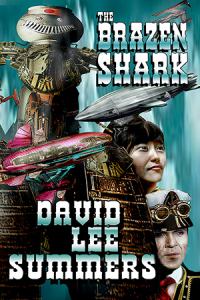 The Brazen Shark is the third novel of my Clockwork Legion series. However, if you haven’t read the first two books, feel free to dive in right here. If you like what you read, you can always go back and read the first two! Set in 1877, this novel tells the story of a one-time sheriff named Ramon Morales who gave up his career in law enforcement to save an outspoken Persian healer named Fatemeh Karimi from a witchcraft trial. We’ve watched their romance develop over the last two books and this is the story of their honeymoon. However, it’s a honeymoon unlike any other when they find themselves embroiled in a plot by samurai warriors who have stolen a Russian airship to overthrow the Japanese emperor. The cover art is by the ever-talented Laura Givens.
The Brazen Shark is the third novel of my Clockwork Legion series. However, if you haven’t read the first two books, feel free to dive in right here. If you like what you read, you can always go back and read the first two! Set in 1877, this novel tells the story of a one-time sheriff named Ramon Morales who gave up his career in law enforcement to save an outspoken Persian healer named Fatemeh Karimi from a witchcraft trial. We’ve watched their romance develop over the last two books and this is the story of their honeymoon. However, it’s a honeymoon unlike any other when they find themselves embroiled in a plot by samurai warriors who have stolen a Russian airship to overthrow the Japanese emperor. The cover art is by the ever-talented Laura Givens.
The Brazen Shark is available in paperback and ebook. The paperback is ready to ship now. The ebook will be sent to your Kindle on February 1, 2016.
While I’m discussing steampunk writing, I’ll remind you there’s still time to support the Kickstarter for Gaslight and Grimm. This awesome anthology project is already funded, so there’s no risk in supporting it at any level. The book features my story “The Steam-Powered Dragon and His Grandmother.” It also features steampunked retellings of “The Three Little Pigs,” “The Nightingale”, “Red Riding Hood” and more by such authors as James Chambers, Jean Marie Ward, and Christine Norris. Lots of great stretch goal bonuses have been added already and if we receive enough funding, we’ll also have stories by Jody Lynn Nye and Gail Z. Martin in the anthology as well. So drop by and reserve your copy of Gaslight and Grimm today!


January 23, 2016
Exploring the Solar System from My Back Yard
When I graduated from high school, my mom bought me an 8-inch Celestron Telescope. To this day, I treasure that telescope and the journeys it’s allowed me to take. I’ve looked at planets, galaxies, and star clusters with the telescope. In my early years of college, when I spent summers working at Cal State San Bernardino, Professor Paul Heckert loaned me a photometer and I even took variable star data with the telescope that we published. However, one thing I’ve always wanted was have a camera to take photos and share. My wife remedied that this past Christmas when she bought me a little Orion StarShoot USB Eyepiece Camera. Unfortunately, the weather has been sufficiently poor since Christmas, I didn’t get a chance to try it out until a little over a week ago. Here I am in my back yard in New Mexico, pointing the telescope at Jupiter.
For my first time out, I was able to get images of both Jupiter and Saturn. The camera works by taking video. Afterwards, the individual video frames may be combined using stacking software. My telescope doesn’t track perfectly. Also, the atmosphere shimmers and dances, especially when you point down near the horizon where Saturn was. This shimmering and dancing is called seeing and the stacking software attempts to take out the effects of poor seeing. My first target was Jupiter. On the left, you see Jupiter. The little bump on the left of the image is its moon Ganymede. The planet has a distinctly reddish cast because I used a red filter to try to cut down the brightness and help me see features on the planet better. The image on the right is saved as grayscale with the contrast turned up. I was amazed at how much detail I could see in the cloud features.
Next, I turned the telescope toward the horizon to catch Saturn. The ringed planet is in a great position right now with it’s rings tilted so they’re easily visible. The image below is at the same scale as the Jupiter images. As you can see, Saturn appears much smaller both because it is smaller than Jupiter and also because it’s farther away. I took a longer video sequence. Most of the images looked terrible and I didn’t think I got a very good image, but when I stacked them, I was amazed at how much detail I could see. I can see the shadow of the planet itself on the rings. I can see the Cassini division in the rings and even a feature in the clouds. Given the poor conditions, I’m very pleased with this image.
Sitting behind the telescope is perhaps the closest I’ll get to exploring the solar system, but I hope we’ll send people to take a closer look. I imagined such a voyage in my novel The Solar Sea. Sitting behind the telescope, I find myself thinking about flying through Jupiter’s clouds or standing on the surface of Titan and seeing Saturn’s rings looming large above me.
If I can manage some clear skies, I hope to try Mars next. I’ve always wanted to climb Olympus Mons, the tallest mountain in the solar system and admire the view from the rim of Valles Marineres, the solar system’s longest canyon. If I get some good Mars pictures, I’ll be sure to share them here.



